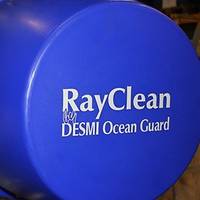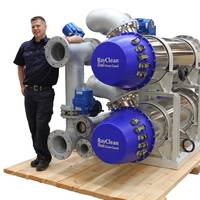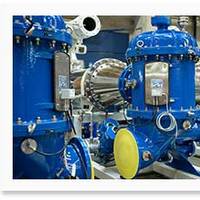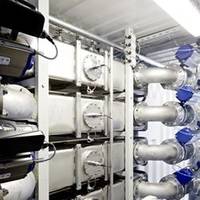DESMI's BWMS Entry Earns USCG Type Approval

The DESMI Ocean Guard CompactClean Ballast Water Management System (BWMS) has received US Coast Guard Type Approval. This approval comes just a few months after the CompactClean BWMS received IMO type approval and means that the system is now approved for worldwide operation.On April 16, 2019 DESMI Ocean Guard’s CompactClean Ballast Water Management System (BWMS) received US Coast Guard (USCG) Type Approval. The approval is valid for all salinities and sea water temperatures, and has no requirement for a special operating mode in US Territory.
USCG Denies DESMI’s BWTS Test Appeal

The U.S. Coast Guard has denied ballast water treatment systems manufacturer DESMI Ocean Guard’s appeal regarding the USCG’s initial decision to reject the use of the MPN test method in type approval testing of ballast water treatment systems. Even though DESMI is considering all options, a test program for the RayClean system has already been launched in order to demonstrate compliance with the FDA test method accepted by the USCG. On July 13, 2016, the U.S. Coast Guard (USCG)…
DESMI Ocean Guard’s BWTS is ATEX Certified

On June 9, 2016 DEKRA EXAM GmbH issued ATEX certificate for DESMI’s RayClean-EX ballast water treatment system. The certificate covers both the RayClean UV unit and the UV control panel powering the UV unit, and enables both these components to be installed in hazardous areas onboard tanker vessels like e.g. oil tankers, chemical tankers and gas carriers. The filter, valves and sensors in the RayClean system can also be delivered in ATEX certified version meaning that all components of the RayClean system except the main control panel can be installed directly in hazardous areas.
Maersk Orders BWTS for 7 Newbuilds

DESMI Ocean Guard A/S to supply ballast water treatment systems to a series of new container vessels to be built at COSCO Zhoushan shipyard in China, for Danish shipper Maersk Line. DESMI Ocean Guard announced that its RayClean ballast water treatment system (BWTS) has been selected for installation on Maersk Line’s series of new containerships to be built at COSCO Zhoushan Shipyard Co., Ltd. The order is for seven vessels each equipped with two RayClean 500 BWTS, with options for two additional vessels. The systems will be delivered in 2016 and 2017.
RayClean BWTS Earns USCG AMS Acceptance

DESMI Ocean Guard’s RayClean Ballast Water Treatment System (BWTS) has earned Alternate Management System (AMS) acceptance from the United States Coast Guard (USCG). On January 30, 2015, the USCG granted AMS acceptance to RayClean BWTS, the system’s developer DESMI Ocean Guard A/S announced today. The AMS acceptance covers all salinities ranging from freshwater to marine water, something that only eight out of 52 issued AMS acceptances have achieved to date. In addition, the RayClean BWTS AMS acceptance contains no limitation with regard to temperature of the water to be treated.
RayClean BWTS is IMO and DNV Type Approved
Ballast water treatment system RayClean, developed by DESMI Ocean Guard, has received IMO and DNV type approval. On September 5, 2014 DNV GL issued type approval certificate for the RayClean system. The type approval certificate includes approval according to both the IMO Ballast Water Management Convention and the DNV type approval program. The type approval is unique because this is the first time a ballast water treatment system has been tested fully according to both IMO and U.S. Coast Guard requirements, DESMI said. This is also revealed on the certificate where it is stated that the RayClean system has undergone 15 land-based tests, five in each salinity, and five shipboard tests as per U.S. Coast Guard test requirements.
Maersk, UltraAqua Divest DESMI Stakes

The partners behind DESMI Ocean Guard A/S today announced that A.P. Moller - Maersk A/S and UltraAqua A/S have sold their shares in DESMI Ocean Guard A/S to DESMI A/S. The transaction gives DESMI A/S full ownership of the company, which presently has two Ballast Water Treatment systems in its portfolio. The newly developed RayClean system was launched recently but has already now secured several orders with the first systems being currently under installation. DESMI Ocean Guard A/S was established by A.P. Moller – Maersk A/S, DESMI A/S and UltraAqua A/S in 2009.
USCG Approves DESMI Ocean Guard for All Salinities

On October 11, 2013, DESMI Ocean Guard’s ballast water treatment system OxyClean was granted U.S. Coast Guard AMS acceptance. The AMS acceptance covers all salinities ranging from freshwater to marine water. This is the first time the USCG has released an AMS acceptance that covers all salinities, as all previously released acceptances are valid in only marine and brackish water, and hence not valid in freshwater. Since the very beginning of the development of the OxyClean system, DESMI said it has been focused on developing a system that will work in all salinities.
DESMI Ocean Guard Release New Ballast Water Treatment System
The RayClean system from DESMI Ocean Guard A/S is a new supplement to the company’s ballast water treatment system (BWTS) product portfolio which already includes the OxyClean system. Both systems are based on mechanical filtration and UV irradiation with low-pressure lamps, but whereas a single OxyClean UV-unit can treat 100 m³/h of ballast water, the RayClean UV units can treat 300 m³/h. This makes the RayClean system more cost competitive at higher flow-rates, DESMI said. The RayClean system sets new standards for the industry with regards to treatment performance and power consumption. When developing the system the goal was to design a unit capable of coping with challenging water conditions and at the same time reduce power consumption to the lowest level in the class.





